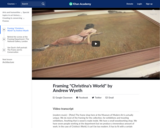
Though we might not notice it, frames affect how we see a painting.
- Subject:
- Art History
- Creative and Applied Arts
- Material Type:
- Lesson
- Provider:
- Khan Academy
- Provider Set:
- Museum of Modern Art
- Author:
- Museum of Modern Art
- Date Added:
- 08/10/2021

Though we might not notice it, frames affect how we see a painting.
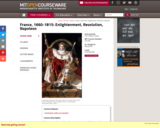
This course covers French politics, culture, and society from Louis XIV to Napoleon Bonaparte. Attention is given to the growth of the central state, the beginnings of a modern consumer society, the Enlightenment, the French Revolution, including its origins, and the rise and fall of Napoleon.
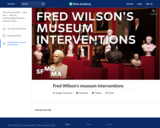
Video by SFMOMA. Beginning in the early 1990s, Fred Wilson shook the museum world with his artistic interventions. At the Maryland Historical Society, he used the conventions of the the museum itself to comment on race, with startling juxtapositions such as 19th century armchairs displayed with slave shackles and a whipping post amongst finely crafted woodworking. His work uncovers inherent cultural biases and disrupts the more traditional way many Americans understand museums. Created by Smarthistory.
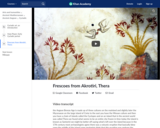
Frescoes from Akrotiri, on the Cycladic island Thera (Santorini), Greece, 16th century B.C.E., Aegean Bronze Age (National Archaeological Museum, Athens). Created by Beth Harris and Steven Zucker.
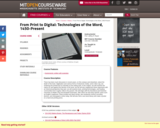
Explores the impact of the printing press upon European politics and culture during the first several centuries after Gutenberg and compares these changes with the possibilities and problems inherent in contemporary electronic technologies of the word. Assignments include formal essays and online projects. There has been much discussion in recent years, on this campus and elsewhere, about the death of the book. Digitization and various forms of electronic media, some critics say, are rendering the printed text as obsolete as the writing quill. In this subject, we will examine the claims for and against the demise of the book, but we will also supplement these arguments with an historical perspective they lack: we will examine texts, printing technologies, and reading communities from roughly 1450 to the present. We will begin with the theoretical and historical overviews of Walter Ong and Elizabeth Eisenstein, after which we will study specific cases such as English chapbooks, Inkan knotted and dyed strings, late nineteenth-century recording devices, and newspapers online today. We will also visit a rare book library and make a poster on a hand-set printing press.

Stunning beadwork and a story of forced migration. Shoulder Bag, 1840-1850, Delaware, Lenni Lenape, cotton, wool, silk, glass beads, tinned iron, brass, bone, 29 1/2 inces high (Newark Museum of Art, Purchase 2017 Mr. and Mrs. William V. Griffin Fund 2017.10) A conversation with Dr. Adriana Greci Green and Dr. Beth Harris A Seeing America video. Find learning related resources here: https://smarthistory.org/seeing-america-2/
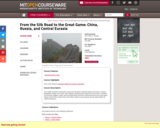
Examines interactions across the Eurasian continent between Russians, Chinese, Mongolian nomads, and Turkic oasis dwellers during the last millennium and a half. As empires rose and fell, religions, trade, and war flowed back and forth continuously across this vast space. Britain and Russia competed for power over Eurasia in the "Great Game" of geopolitics in the nineteenth century, just as China, Russia, and others did in the twentieth century. Today, the fall of the Soviet Union and China's reforms have opened new opportunities for cultural interaction. Topics include: the religious traditions of Central Asian Islam, Buddhism, Christianity, and Confucianism; caravans and travelers like Marco Polo and Rabban Sauma, the first Chinese to travel to the West; and nomadic conquest and imperialist competition, past and present. Source materials include primary documents, travelogues, films, music, and museum visits.
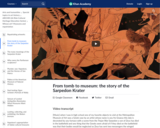
Euphronios, Sarpedon Krater, (signed by Euxitheos as potter and Euphronios as painter), c. 515 B.C.E., red-figure terracotta, 55.1 cm diameter (National Museum Cerite, Cerveteri, Italy) Speakers: Dr. Erin Thompson and Dr. Steven Zucker. Created by Beth Harris and Steven Zucker.
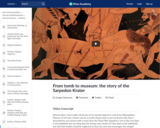
Euphronios, Sarpedon Krater, (signed by Euxitheos as potter and Euphronios as painter), c. 515 B.C.E., red-figure terracotta, 55.1 cm diameter (National Museum Cerite, Cerveteri, Italy) Speakers: Dr. Erin Thompson and Dr. Steven Zucker. Created by Beth Harris and Steven Zucker.

Christ Triumphant (Christus triumphans), also known as the 432 Cross, tempera on panel, c. 1180–1200, 277 x 231 cm and Crucifix and Eight Stories from the Passion (Christus patiens), also known as the 434 Cross, c. 1240, tempera on panel, 247 x 201 cm (both in the Uffizi, Florence) A conversation with Dr. Steven Zucker and Dr. Beth Harris. Created by Beth Harris, Smarthistory, and Steven Zucker.
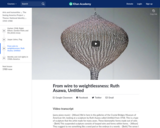
From wire to weightlessness: Ruth Asawa, Untitled. Ruth Asawa, Untitled, c. 1958, iron wire, 219.7 × 81.3 × 81.3 cm Crystal Bridges Museum of American Art. Speakers: Allison Glenn and Beth Harris. Find learning related resources here: https://smarthistory.org/seeing-america-2/
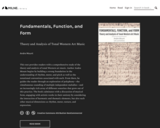
This text provides readers with a comprehensive study of the theory and analysis of tonal Western art music. Author Andre Mount begins by building a strong foundation in the understanding of rhythm, meter, and pitch as well as the notational conventions associated with each. From there, he guides the reader through an exploration of polyphony—the simultaneous sounding of multiple independent melodies—and an increasingly rich array of different sonorites that grow out of this practice. The book culminates with a discussion of musical form, engaging with artistic works in their entirety by considering the interaction of harmonic and thematic elements, but also such other musical dimensions as rhythm, meter, texture, and expression.
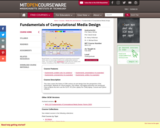
" This class covers the history of 20th century art and design from the perspective of the technologist. Methods for visual analysis, oral critique, and digital expression are introduced. Class projects this term use the OLPC XO (One Laptop Per Child) laptop, Csound and Python software."

This design-based subject provides a first course in energy and thermo-sciences with applications to sustainable energy-efficient architecture and building technology. No previous experience with subject matter is assumed. After taking this subject, students will understand introductory thermodynamics and heat transfer, know the leading order factors in building energy use, and have creatively employed their understanding of energy fundamentals and knowledge of building energy use in innovative building design projects. This year, the focus will be on design projects that will complement the new NSTAR/MIT campus efficiency program.
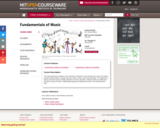
Introduces students to the basics of musical structure and proficiencies expected of musicians through participation in three integrated hands-on approaches. Lectures introduce students to the basics of music--pitch, rhythm, and its combinations--in a variety of musical settings, including analysis and discussion of students' compositions and of related larger works. Sight-singing lab focuses on developing practical musical skills through oral, aural, and written experiences with rhythms, melodies, intervals, scales, chords, and music notation. Piano lab introduces and continues development of fundamental music skills through keyboard practice.
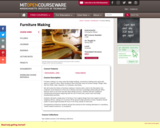
Furniture making is in many ways like bridge building, connections holding posts apart with spans to support a deck. Many architects have tried their hand at furniture design, Wright, Mies Van Der Rohe, Aalto, Saarinen, Le Corbusier, and Gerhy. We will review the history of furniture making in America with a visit to the Decorative Arts Collection at the Museum of Fine Arts in Boston and have Cambridge artist/craftsman Mitch Ryerson show us his work and talk about design process. Students will learn traditional woodworking techniques beginning with the use of hand tools, power tools and finally woodworking machines. Students will build a single piece of furniture of an original design that must support someone weighing 185 lbs. sitting on it 12 inches off the ground made primarily of wood. Students should expect to spend approximately 80 hours in the shop outside of class time. Preregistered architecture students will get first priority but first meeting attendance is mandatory. Twelve student maximum, no exceptions.
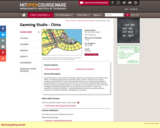
The studio will focus on the district of Gaoming, located in the northwest of the Pearl River Delta (PRD) - the fastest growing and most productive region of China. The District has recently completed a planning effort in which several design institutes and a Hong Kong planning firm prepared ideas for a new central area near the river. The class will complement these efforts by focusing on planning and design options on the waterfront of the proposed new district and ways of integrating water/hydrological factors into all aspects and land uses of a modern city (residential, commercial, industrial) - including watershed and natural ecosystem protection, economic and recreational activities, transportation, and tourism.
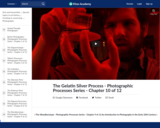
The gelatin silver process was introduced at the end of the nineteenth century and dominated black-and-white photography in the twentieth century. The paper or film used to make gelatin silver prints and negatives is coated with an emulsion that contains gelatin and silver salts. Gelatin silver prints and negatives are developed out rather than printed out, which means that exposure to light registers a latent image that becomes visible only when developed in a chemical bath. This process requires shorter printing times than earlier printed-out processes such as salted paper prints and albumen prints. George Eastman’s introduction of flexible roll film and the Brownie camera revolutionized photographic practice and industry, putting photography into the hands of the masses for the first time. This process is responsible for all the black and white, color and motion pictures produced in the 20th century with analog materials. This project is made possible by a grant from the U.S. Institute of Museum and Library Services, grant number MA-10-13-0194.
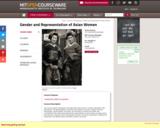
This course explores stereotypes associated with Asian women in colonial, nationalist, state-authoritarian, and global/diasporic narratives about gender and power. Students will read ethnography, cultural studies, and history, and view films to examine the politics and circumstances that create and perpetuate the representation of Asian women as dragon ladies, lotus blossoms, despotic tyrants, desexualized servants, and docile subordinates. Students are introduced to the debates about Orientalism, gender, and power.
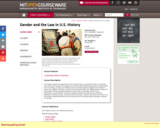
This subject explores the legal history of the United States as a gendered system. It examines how women have shaped the meanings of American citizenship through pursuit of political rights such as suffrage, jury duty, and military service, how those political struggles have varied for across race, religion, and class, as well as how the legal system has shaped gender relations for both women and men through regulation of such issues as marriage, divorce, work, reproduction, and the family. The course readings will draw from primary and secondary materials in American history, as well as some court cases. However, the focus of the class is on the broader relationship between law and society, and no technical legal knowledge is required or assumed.